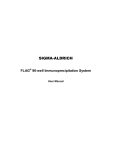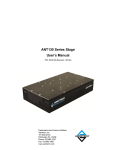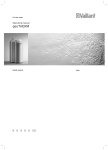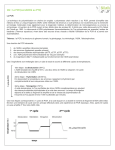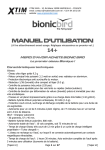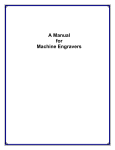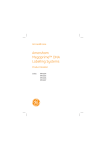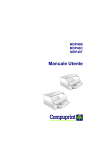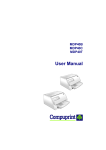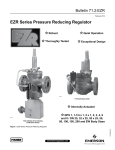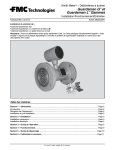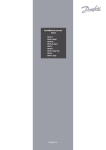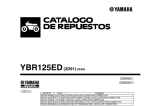Download Director™ Universal Cloning System - Sigma
Transcript
Director™ Universal Cloning System User Manual Product Codes: RDC1 RDCLIG1 RDCL3 Director™ Universal Cloning System Manual 1.0 TABLE OF CONTENTS 1.0 Table of contents ................................................................................................................................ 1 License Agreement ................................................................................................................................................... 2 Precautions and Disclaimer .......................................................................................................................................... 2 2.0 Director™ Universal Cloning System Components........................................................................ 3 Director Universal PCR System (Product Code RDC1) ....................................................................... 3 Director-Ready™ Vector Sets .............................................................................................................. 3 Director-Ready pFLAG-MAC™ (Product Code RDCLIG1) ....................................................... 3 Director-Ready pFLAG-CMV™-2 (Product Code RDCL3) ......................................................... 3 3.0 Introduction ......................................................................................................................................... 4 3.1 Application.................................................................................................................................... 4 3.2 Features and Benefits .................................................................................................................. 4 4.0 Director Universal Cloning System Overview ................................................................................. 5 5.0 Director Universal PCR System ........................................................................................................ 6 5.1 Reagents Provided....................................................................................................................... 6 5.2 Additional Reagents and Equipment (Not Supplied) ................................................................... 6 5.3 Storage......................................................................................................................................... 6 6.0 General Considerations ..................................................................................................................... 7 6.1 Template DNA.............................................................................................................................. 7 6.2 Primer Design............................................................................................................................... 7 6.3 DNA Polymerases ........................................................................................................................ 7 6.4 PCR Conditions............................................................................................................................ 7 7.0 Protocols for the Director Universal PCR System .......................................................................... 8 7.1 Setting up Control PCR................................................................................................................ 8 7.2 Setting up Sample PCR ............................................................................................................... 9 7.3 Exonuclease III Digestion............................................................................................................. 9 7.4 Purification of PCR Products........................................................................................................ 9 8.0 Abbreviated Procedure for Experienced Users ............................................................................... 10 9.0 Director-Ready™ Vector Sets.......................................................................................................... 12 9.1 Reagents Provided..................................................................................................................... 12 9.2 Additional Reagents and Equipment (Not Supplied) ................................................................. 12 9.3 Storage....................................................................................................................................... 12 10.0 General Considerations ................................................................................................................... 13 11.0 Protocols for the Director-Ready Vector Sets ............................................................................... 13 11.1 Ligation of PCR Products........................................................................................................... 13 11.2 Transformation of Ligation Product ............................................................................................ 14 11.3 Verification of Transformants ..................................................................................................... 14 11.3.1 Pick colonies ..................................................................................................................14 11.3.2 PCR setup......................................................................................................................14 11.3.3 PCR profile..................................................................................................................... 15 11.3.4 Gel electrophoresis ........................................................................................................ 15 11.3.5 Expected results............................................................................................................. 15 11.3.6 Verification of ligation reactions (optional) ..................................................................... 16 12.0 Troubleshooting Guide .................................................................................................................... 17 13.0 References......................................................................................................................................... 19 Version Date 10-05-05 1 Director™ Universal Cloning System Manual 14.0 Related Products .............................................................................................................................. 20 APPENDIX 1: Cleavage Sites/PCR Primer Sequences for most Commonly Used 5c-Overhang– c producing Restriction Enzymes...................................................................................................... 21 APPENDIX 2: pFLAG-MAC Bacterial Expression Vector Information ................................................. 22 APPENDIX 3: pFLAG-CMV-2 Mammalian Expression Vector Information .......................................... 23 APPENDIX 4: Verification Primer Sequences......................................................................................... 24 LICENSE AGREEMENTS NOTICE TO PURCHASER: LIMITED LICENSE Use of this product is covered by one or more of the following US patents and corresponding patent claims outside the US: 5,789,224, 5,618,711, 6,127,155 and claims outside the US corresponding to expired US Patent No. 5,079,352. The purchase of this product includes a limited, non-transferable immunity from suit under the foregoing patent claims for using only this amount of product for the purchaser’s own internal research. No right under any other patent claim, no right to perform any patented method, and no right to perform commercial services of any kind, including without limitation reporting the results of purchaser’s activities for a fee or other commercial consideration, is conveyed expressly, by implication, or by estoppel. This product is for research use only. Diagnostic uses under Roche patents require a separate license from Roche. Further information on purchasing licenses may be obtained by contacting the Director of Licensing, Applied Biosystems, 850 Lincoln Centre Drive, Foster City, California 94404, USA. PRECAUTIONS AND DISCLAIMER Sigma Director™ Universal Cloning System is for laboratory use only; not for drug, household or other uses. Director, Director-Ready, ExoClone, pFLAG-CMV, pFLAG-MAC, JumpStart, REDAccuTaq, AccuTaq, Quick-Link, ESCORT, EZMix, GenElute, MAT, CelLytic, and EZView are trademarks of Sigma-Aldrich Co. FLAG and ANTI-FLAG are registered trademarks of Sigma-Aldrich Co. GC5 is a trademark of GeneChoice, Inc. Sigma brand products are sold through Sigma-Aldrich, Inc. Sigma-Aldrich, Inc. warrants that its products conform to the information contained in this and other Sigma-Aldrich publications. Purchaser must determine the suitability of the product(s) for their particular use. Additional terms and conditions may apply. Please see reverse side of the invoice or packing slip. 2 09-17-10 Version Date 10-05-05 Director™ Universal Cloning System Manual 2.0 DIRECTOR™ UNIVERSAL CLONING SYSTEM COMPONENTS Director Universal PCR System (Product Code RDC1) • JumpStart™ REDAccuTaq™ LA DNA Polymerase • 10× AccuTaq™ LA DNA Polymerase Buffer • ExoClone™ dNTP Mix (20X) • Control PCR Template • Control RDC primer-F (with 5′-phosphorylation) • Control RDC primer-R (with 5′-phosphorylation) • Exonuclease III • Molecular Biology Reagent Water Storage Conditions: Store all components at –20 °C. Avoid multiple freeze-thaw cycles. Director-Ready™ Vector Sets Director-Ready vectors are pre-digested with Hind III and Bgl II. Director-Ready pFLAG-MAC™ (Product Code RDCLIG1) • Director-Ready pFLAG-MAC Expression Vector • Verification primer-BF • Verification primer-BR Storage Conditions: Store all components at –20 °C. Avoid multiple freeze-thaw cycles. Director-Ready pFLAG-CMV™-2 (Product Code RDCL3) • Director-Ready pFLAG-CMV-2 Expression Vector • Verification primer-MF • Verification primer-MR Storage Conditions: Store all components at –20 °C. Avoid multiple freeze-thaw cycles. Version Date 10-05-05 3 Director™ Universal Cloning System Manual 3.0 INTRODUCTION The cloning and expression of a large number of genes has been an enormous challenge for gene function studies in the post-genomics era. One of the major limitations has been the lack of a pair of universal restriction enzymes for generating the cohesive ends required for directional cloning. Therefore, different enzymes are used for cloning different genes, which restricts throughput and increases workload. The Sigma Director™ Universal Cloning system is an ExoClone™ technology-based solution that provides a simple, rapid and universal method to facilitate the ligation of PCR products into vectors cleaved with 5′-overhang–producing restriction endonucleases. Directionality is obtained by pairing directionally designed PCR primers with an appropriately digested plasmid vector. The complete system includes a universal PCR kit and two Director-Ready vector kits. The PCR kit is designed for the generation of DNA inserts ready for directional cloning into any expression vector, including the two vectors included with the kit. It differs from conventional PCR kits in that it uses a specially formulated dNTP mix containing dATPαS, dGTPαS and Exonuclease III. After PCR, the cohesive 5′-termini of the amplicon are produced by Exonuclease III digestion instead of being generated by traditional restriction enzyme digestions. Incorporation of dA/GTPαS into the amplicon provides a convenient method for protecting the amplicon from overdigestion by 1 Exonuclease III. The nucleotide mix in the kit is formulated so that the amplicon terminates at a statistically determined 2 array of 3′-dA/GαS sites. PCR primers are designed such that the 5′-termini complement the 5′-overhangs of predigested cloning vectors. Each of the Director-Ready vector sets contains one FLAG-expression vector, predigested and dephosphorylated, along with sequencing primers for verification of transformants. These ligation-ready vectors are designed to optimize efficient directional cloning of PCR products. The typical cloning efficiency using these vectors is greater than 90% (transformants with a positive insert in the desired orientation). 3.1 Application • 3.2 4 PCR-based directional cloning of genes (ORFs) for expression studies Features and Benefits • Directional cloning allows rapid gene expression • No limit on restriction enzyme selection allows rapid cloning of a large number of genes in any expression vector • Use Director-Ready Vectors or create your own • Typical cloning efficiency (using the Director-Ready vectors) is greater than 90% • Simple procedure increases throughput while decreasing hands-on time Version Date 10-05-05 Director™ Universal Cloning System Manual 4.0 DIRECTOR™ UNIVERSAL CLONING SYSTEM OVERVIEW Figure 1. Outline of the Procedure. Select a cloning vector and restriction enzymes for double digestion ↓ Design PCR primers (incorporating the desired restriction sites) for amplification of a target gene ↓ PCR amplification using the ExoClone dNTP mix ↓ Exonuclease III digestion of PCR product ↓ Purification and quantification of Exonuclease III-treated PCR product ↓ Ligation of PCR product into predigested vectors ↓ Transformation into competent cells ↓ Verification of positive clones by PCR and/or sequencing Version Date 10-05-05 5 Director™ Universal Cloning System Manual 5.0 DIRECTOR™ UNIVERSAL PCR SYSTEM This is a universal kit for generating Director compatible (ExoClone™) PCR inserts. Reagents provided are sufficient for 25 PCR amplifications. 5.1 Reagents Provided Kit Components Product Number Quantity JumpStart™ REDAccuTaq™ LA DNA Polymerase D1938 62.5 µl (1 u/µl) 10X AccuTaq™ LA DNA Polymerase Buffer (500 mM Tris-HCl, 150 mM Ammonium Sulfate [pH 9.3], 25 mM MgCl2, 1% Tween® 20) B0174 0.5 ml ExoClone dNTP Mix (20X) E4280 62.5 µl Control PCR Template D4314 10 µl (1 ng/µl) Control RDC primer-F (with 5′ phosphorylation) 5′-p-AGC TTC TCG AGA TGC CTG TTC TG-3′ P4986 25 µl (20 µM) Control RDC primer-R (with 5′ phosphorylation) 5′-p-GAT CTT CTG CCA TTA AGT CTG GTT GCT AAC-3′ P5111 25 µl (20 µM) Exonuclease III E1131 25 µl (100 u/µl) Molecular Biology Reagent Water W4502 1.5 ml 5.2 Additional Reagents and Equipment (Not Supplied) • Target template DNA • Gene-specific primers for sample PCR • Dedicated pipettes and aerosol resistant pipette tips • 0.5 or 0.2 ml thin-walled PCR microcentrifuge tubes • Thermal cycler • PCR marker (Product Code P9577) • 0.8-1% agarose gel (Product Code A9539) • 10X Tris-Borate-EDTA buffer (TBE) (Product Code T4415) • GeneElute PCR Purification kit (NA1020). 5.3 Storage • GeneElute Gel Extraction kit (Product Code NA1111) • 100X Tris-EDTA buffer (Product Code T9285) • 1M Tris-HCl (pH 8.0) (Product Code T3038) • 0.5 M EDTA Na2 (Product Code E7889) • 5.0 M NaCl (Product Code S6546) • LB Agar Ampicillin Plates (100 µg/ml ampicillin) (Product Code L5667) • 2× JumpStart REDTaq ReadyMix (Product Code P0982) All components should be stored at –20 °C. Avoid multiple freeze-thaw cycles. 6 Version Date 10-05-05 Director™ Universal Cloning System Manual 6.0 GENERAL CONSIDERATIONS Please read this section thoroughly before starting your experiment. 6.1 Template DNA The system is compatible with different sources of DNA template, including plasmid DNA, cDNA, and genomic DNA. However, PCR performance may be affected by the complexity and purity of the DNA template. 6.2 Primer Design • One set of 5′-overhang–producing restriction endonuclease cleavage sites should be incorporated in each 5′-end of the gene-specific primers. Theoretically, any restriction enzyme can be chosen (without consideration of whether it has internal cleavage sites within a specific open reading frame), since Exonuclease III digestion will subsequently create the appropriate cohesive ends. However, the restriction enzyme sites in the PCR primers must match those in the chosen vector. For a list of commonly used 5′-overhang–producing restriction endonucleases, see Appendix I. For the control insert, a Hind III overhang compatible site (5′-AGCTT-3′) and a Bgl II overhang compatible site (5′-GATCT-3′) have been incorporated in the forward control primer and reverse control primer, respectively. Director-Ready™ vectors are also compatible with inserts generated using Hind III and Bgl II sequences. 5′pAGCTTNNN NNNTCTAGp5′ • Vector maps and MCS regions for the uncut parent vectors of Director-Ready vectors are found in Appendices 2 and 3. A leucine residue is encoded by the last three nucleotides (CTT) in the Hind III cleavage site of the forward control primer. • Both primers must be 5′-phosphorylated. This can be done during primer synthesis. • Primers should be ≥20 bp (specific target sequence plus 5 bases for restriction site) to achieve adequate specificity; however, the length can vary depending on the sequence content of selected region. The Tm, GC content of primers, and complexity of the template DNA are important considerations in successful PCR. We recommend that Tm of your primers be between 65-75 °C with GC content greater than 40%. 6.3 DNA Polymerases The kit uses JumpStart REDAccuTaq LA DNA polymerase for PCR amplification. This special enzyme blend offers several advantages over conventional Taq polymerases: excellent amplification for longdistance PCR (up to 22 kb for complex genomic DNA and 40 kb for less-complex templates); high fidelity (6.5X higher using standard nucleotide mixes than Taq polymerase and comparable to Pfu polymerase); hot-start mechanism using JumpStart antibody to prevent nonspecific product formation, improving specificity; and direct loading of PCR products onto an agarose gel without the addition of loading buffers, saving time in product characterization. Other DNA polymerases are also compatible with this kit; however, additional PCR optimization may be required to obtain comparable results. 6.4 PCR Conditions PCR conditions need to be determined empirically for each set of specific primers and template. It is critical to optimize PCR conditions for high specificity, i.e., generating a single product band, to avoid the need for further gel purification. A “hot-start” mechanism using JumpStart antibody, which significantly 3 improves PCR specificity, has been incorporated in this kit. For most applications, you should only need to adjust the annealing temperature and extension time according to the Tm of the primers and the length Version Date 10-05-05 7 Director™ Universal Cloning System Manual of the template. However, other techniques such as using “touchdown” PCR may further improve the 4 specificity of amplification. 7.0 PROTOCOLS FOR THE DIRECTOR UNIVERSAL PCR SYSTEM 7.1 Setting up Control PCR The control PCR template in this system is supplied so that you may test the system performance (efficiency of PCR amplification, cloning, etc.). The primers included with the control template are designed so that the amplicon will contain a full-length 1485 base pair bacterial alkaline phosphatase gene (GenBank # 16128368) with a Hind III compatible restriction site at the 5′-end and a Bgl II compatible restriction site at the 3′-end. These restriction sites allow directional insertion of the PCR product into a Hind III/Bgl II double-digested vector (e.g., Sigma’s Director-Ready vectors). We recommend that you run the control PCR along with your sample reactions. Note: We do not recommend the use of DMSO or formamide with JumpStart REDAccuTaq LA DNA Polymerase due to interference with the enzyme-antibody complex. Other cosolvents, salts, and extremes in pH or other reaction conditions may reduce the affinity of the JumpStart antibody for the Taq polymerase and thereby compromise its effectiveness. 1. Mix the following components in a 0.2 ml or 0.5 ml PCR tube. The reaction should be set up on ice. 2. 5 µl 10X AccuTaq LA DNA Polymerase Buffer 2.5 µl ExoClone dNTP Mix (20X) 1 µl Control RDC Primer-F (20 µM) 1 µl Control RDC Primer-R (20 µM) 1 µl 1:4 dilution of Control PCR Template (diluted to 250 pg/µl) 2.5 µl JumpStart REDAccuTaq LA DNA Polymerase (1 u/µl) 37 µl Water 50.0 µl Total Volume PCR Amplification: Initial denaturation: 95 °C, 3 minutes 30 cycles 8 Denaturation: 94 °C, 30 seconds Annealing/Extension: 68 °C, 2 minutes Final extension: 68 °C, 5 minutes Soak: 4 °C Version Date 10-05-05 Director™ Universal Cloning System Manual 7.2 Setting up Sample PCR 1. Add the following components in 0.2 ml or 0.5 ml PCR tubes. Reactions should be set up on ice. 5 µl 10X AccuTaq LA DNA Polymerase Buffer 2.5 µl ExoClone dNTP Mix (20X) 1 µl Forward Custom Primer (20 µM) 1 µl Reverse Custom Primer (20 µM) x µl Sample PCR template 2.5 µl JumpStart REDAccuTaq LA DNA Polymerase (1 u/µl) 38–x µl Water 50.0 µl Total Volume 2. The PCR amplification profile will vary depending on the Tm value of the specific primer set and the length of the template. We recommend setting the annealing temperature 3-5 °C below the Tm of the primers and the extension time at 1-1.5 minute/kb template length. If the Tm of the custom primers is above 75 °C, use a two-step PCR profile as illustrated by the control reaction (94 °C for denaturation and 68 °C or 72 °C for annealing/extension). Analyze the PCR product by agarose gel electrophoresis 7.3 Exonuclease III Digestion 1. After PCR, add 1 µl of Exonuclease III to each 50 µl PCR (final concentration of 2 units/µl). 2. Mix thoroughly. 3. Incubate in a water bath at 37 °C for 15 minutes. 7.4 Purification of PCR Products 1. If PCR results reveal a single amplification band with a reasonable yield, proceed to a postreaction clean-up using Sigma-Aldrich PCR Purification kit (Product Code NA1111). 2. If PCR results reveal more than one band, gel purification should be performed in order to obtain a specific PCR product Sigma-Aldrich Gel Extraction kit (Product Code NA1020). 3. If no PCR product is observed, check the PCR conditions. Refer to the troubleshooting guide in this manual for assistance with optimizing PCR conditions. 4. Proceed to ligation and transformation in sections 9-11 (following the Abbreviated Procedure for Experienced Users). Version Date 10-05-05 9 Director™ Universal Cloning System Manual 8.0 ABBREVIATED PROCEDURE FOR EXPERIENCED USERS Note: STEP 1: This procedure is intended for users who are familiar with PCR and have performed these reactions previously. Inexperienced or first-time users should refer to the complete procedures in Section 7. Set up PCR to generate DNA inserts. ABBREVIATED PROCEDURE FOR EXPERIENCED USERS Control reaction: 5 µl 10X AccuTaq LA DNA Polymerase Buffer 2.5 µl ExoClone dNTP Mix (20X) 1 µl Control RDC Primer-F (20 µM) 1 µl Control RDC Primer-R (20 µM) 1 µl 1:4 dilution of Control PCR Template (diluted to 250 pg/µl) 2.5 µl JumpStart REDAccuTaq LA DNA Polymerase (1 u/µl) 37 µl Water 50 µl Total Volume Sample reaction: 5 µl 10X AccuTaq LA DNA Polymerase Buffer 2.5 µl ExoClone dNTP Mix (20X) 1 µl Forward Custom Primer (20 µM) 1 µl Reverse Custom Primer (20 µM) x µl Custom PCR Template 2.5 µl JumpStart REDAccuTaq LA Polymerase (1 u/µl) 38-x µl Water 50 µl Total Volume 10 Version Date 10-05-05 Director™ Universal Cloning System Manual STEP 2: PCR amplification. Protocols optimized for the control template/primers and the specific template/primers are described below: Control PCR: Initial denaturation: 95 °C, 3 minutes 30 cycles Denaturation: 94 °C, 30 seconds Annealing/Extension: 68 °C, 2 minutes 68 °C, 5 minutes Soak: 4 °C Sample PCR (see Section 7.2) STEP 3: Exonuclease III digestion. Add 1 µl of Exonuclease III to each PCR and incubate at 37 °C for 15 minutes. STEP 4: Purification of PCR product. Use a PCR clean-up kit or a gel extraction kit (if PCR shows multiple bands). STEP 5: Optional quantification of insert DNA. Analyze the PCR products by agarose gel electrophoresis STEP 6: Ligation of insert DNA and vector. PCR products may be rapidly ligated into DirectorReady vectors usingT4 DNA Ligase. Using 1 µl (50 ng) of vector, mix insert:vector at a molar ratio of 1:1 to 10:1. STEP 7: Transformation of ligation product. Add 1-2 µl of ligation product to one tube of competent cells according to the manufacturers instructions. If using the recommended GC5™ Competent Cells (Product Code G3169), place the tube on ice for 30 minutes. Heat the tube for 45 seconds in a 42 °C water bath. Place the tube on ice for 2 minutes. Add 450 µl of room temperature SOC medium to the tube. Shake the tube at 37 °C, 225 rpm for 1 hour. Plate 100 µl on a LB-Amp plate and grow at 37 °C overnight. STEP 8: PCR verification of transformants. A variety of methods can be used to verify positive transformants, including restriction digestion, sequencing, and PCR. Section 11.3 contains a PCR-based rapid verification procedure, suitable for screening a large number of transformants using verification primers provided in the Director-Ready Vector Kits. Version Date 10-05-05 11 ABBREVIATED PROCEDURE FOR EXPERIENCED USERS Final extension: Director™ Universal Cloning System Manual 9.0 DIRECTOR-READY VECTOR SETS 9.1 Reagents Provided The Director-Ready pFLAG-MAC Set is used for cloning and cytoplasmic expression of N-terminal Met-FLAG fusion proteins in E. coli. Reagents provided in the kit are sufficient for 20 reactions. Kit Component Product Number Quantity Director-Ready pFLAG-MAC L9158 20 µl (50 ng/µl) Verification primer-BF (5′ TGG CAA ATA TTC TGA AAT GAG C 3′) P5361 50 µl (20 µM) Verification primer-BR (5′ CTA CGG CGT TTC ACT TCT GAG T 3′) P5486 50 µl (20 µM) The Director-Ready pFLAG-CMV2 Set is used for cloning and transient intracellular expression of N terminal Met-FLAG fusion proteins in mammalian cells. Reagents provided in the kit are sufficient for 20 reactions. Kit Component Product Number Quantity Director-Ready pFLAG-CMV2 L0156 20 µl (50 ng/µl) Verification primer-MF (5′ AAT GTC GTA ATA ACC CCG CCC CGT TGA CGC 3′) P2987 50 µl (20 µM) Verification primer-MR (5′ TAT TAG GAC AAG GCT GGT GGG CAC 3′) P3112 50 µl (20 µM) 9.2 Additional Reagents and Equipment (Not Supplied) • Dedicated pipettes and aerosol-resistant pipette tips • Quick-Link™ DNA ligation kit (Product Code LIG2) or other T4 DNA Ligase (Product Code D2886) • Competent cells, such as GC5 Uni-packs (Product Code G3169) • LB-Ampicillin agar plates • 2X JumpStart REDTaq ReadyMix (Product Code P0982) • 0.2 or 0.5 ml thin-walled PCR microcentrifuge tubes • Thermal cycler • PCR marker (Product Code P9577) • 0.8%-1% agarose gel (Product Code A9539) • 10X Tris-Borate-EDTA buffer (TBE; Product Code T4415) 9.3 Storage All components should be stored at –20 °C. Avoid multiple freeze-thaw cycles. 12 Version Date 10-05-05 Director™ Universal Cloning System Manual 10.0 GENERAL CONSIDERATIONS The ExoClone PCR product generated by this system can be cloned into a variety of commercial vectors, including Sigma’s FLAG series of expression vectors. When using vectors other than those included with this system, common precautions for preparing double-digested vectors should be taken to minimize the background caused by incomplete digestion. We highly recommend dephosphorylating the vector after restriction digestion, in order to decrease the cloning background. Since Exonuclease III-treated PCR products contain only 5′-overhangs, you should choose 5′-overhang–producing restriction enzymes for both vector preparation and insert PCR primer design. Note: Please refer to Appendix I for the cleavage sites/PCR primer sequences for most commonly used 5′-overhang–producing restriction enzymes. 11.0 PROTOCOLS FOR THE DIRECTOR-READY VECTOR SETS 11.1 Ligation of PCR Products • Insert: Since the vectors in Director-Ready Vector Sets are predigested with Hind III and Bgl II, the insert (either generated by restriction digestion or via the ExoClone method) must have a Hind III compatible site at the 5′-end and a Bgl II compatible site at the 3′-end. We recommend that the insert generated from the control template and primers in the Director Universal Cloning System be used. This will serve as a positive control for cloning efficiency. • Molar ratio of insert:vector: The optimal insert:vector molar ratio for Director Universal Cloning System is 5-10:1, which is higher than the conventional 3:1 ratio used in cohesive-end ligation. Extreme insert size or large vectors could also alter the molar ratio for optimal ligation performance. Equation: molar ratio of insert:vector = mass of insert mass of vector × size of vector size of insert • Ligase: The ligation reactions should be performed using Sigma’s T4 DNA Ligase (Product Code D2886) or another qualified ligation product. Follow the manufacturer’s instructions. The following protocol is provided as an example. 1. Thaw the quantified control, sample insert DNA, the chosen Director-Ready Vector Kit and the ligase on ice. Thaw the other tubes at room temperature. Vortex each tube briefly and then spin them down for a few seconds. Once thawed, keep each reagent on ice. 2. Set up the ligation reaction: _ µl H2O _ µl Control insert or sample insert _ µl Director-Ready vector or custom vector (50 ng) _ µl Ligation buffer 19 µl Total Volume Version Date 10-05-05 13 Director™ Universal Cloning System Manual 3. Add 1 µl of T4 DNA ligase. Mix thoroughly and incubate at room temperature for at least 60 minutes. Note: Typically, 60 minutes is long enough for ligations performed with optimal insert:vector ratios. A longer ligation time may be required if reactions are performed with suboptimal insert:vector ratios. In this situation, an optimization experiment should be performed to determine optimal cloning efficiency. Rapid ligation kits such as Quick-Link™ (Product Code LIG2) may also be used. 11.2 Transformation of Ligation Product 7 Competent cells with transformation efficiencies ≥10 cfu/µg DNA are suitable. GC5 Competent Cells 9 (Product Codes G3169 and G3044) are recommended (transformation efficiency is ≥10 cfu/µg DNA). Different E. coli strains, such GC5, JM109 (Product Code J3895) or BL21 (Product Codes B2685, B2935, B3310 and B3435) competent cells, can be used for transformation. However, since competent cells are very sensitive to temperature changes and storage conditions, extreme caution should be taken to avoid freeze-thaw cycles and extended storage times (e.g., >6 months). Follow the manufacturer’s instructions for recommended transformation procedures. 11.3 Verification of Transformants A variety of methods can be used to verify positive transformants, including restriction digestion, sequencing, and PCR. The following section contains a PCR-based rapid verification procedure, suitable for screening a large number of transformants using verification primers provided in the Director-Ready Vector Kit. 11.3.1 Pick colonies Optimal PCR results are obtained when small (~1 mm in diameter) colonies are picked from a freshly grown plate. Typically, the colony is resuspended in 50 µl of H2O, use 9.2 µl for PCR amplification and keep the rest at 4 °C for additional culturing following verification. 11.3.2 PCR setup 9.2 µl Bacteria-containing H2O 10 µl JumpStart REDTaq ReadyMix DNA polymerase (2X) 0.4 µl Verification primer-F (20 pmol/µl or 20 µM stock) 0.4 µl Verification primer-R (20 pmol/µl or 20 µM stock) 20 µl X number of reactions 14 Version Date 10-05-05 Director™ Universal Cloning System Manual 11.3.3 PCR profile Initial denaturation: 94 °C, 5 minutes 30 cycles Denaturation: 94 °C, 30 seconds Annealing: 62 °C, 30 seconds Extension: 68 °C, 3 minutes Final extension: 68 °C, 10 minutes Soak: 4 °C 11.3.4 Gel electrophoresis Load 5 µl PCR marker in lane #1 of a 0.8%-1% agarose gel. Load 10 µl of each PCR in the remaining lanes. Run the gel in 1X TBE buffer until the tracking dye is 1 cm from the bottom of the gel. 11.3.5 Expected results The Verification PCR primers provided with the kits flank the MCS regions of Director-Ready vectors. Therefore, after PCR, the negative transformants (resulting from self-ligation) will produce a 0.4 kb product, whereas the positive transformants should result in a product equal to 0.4 kb plus the size of insert (e.g., a 1.8 kb product for the control insert). If there is no visible PCR product, the PCR was not successful. Alternatively, one of the verification PCR primers could be used in combination with an insertspecific primer to check for the presence and orientation of the insert. The drawback of this approach is that it cannot determine whether a negative result was caused by the absence of an insert or PCR failure. Version Date 10-05-05 15 Director™ Universal Cloning System Manual 11.3.6 Verification of ligation reactions (optional) A simple and sensitive assay using PCR can be used to check the ligation reaction if the transformation results are not satisfactory. PCR should be set up as follows: 8.2 µl H2O 10 µl JumpStart REDTaq ReadyMix (2X) 0.4 µl Verification primer-F (20 pmol/µl or 20 µM stock) 0.4 µl Verification primer-R (20 pmol/µl or 20 µM stock) 1.0 µl Ligation product or serial-dilution of ligation product 20 µl X number of reactions The same PCR profile as described in Section 11.3.3 can be used with this sample. If the PCR results are negative, it could rule out the possibility of any transformation-related issues. Please refer to the Troubleshooting Guide (Section 12.0) for helpful suggestions. 16 Version Date 10-05-05 Director™ Universal Cloning System Manual 12.0 TROUBLESHOOTING GUIDE Problem No PCR product is observed in ExoClone PCR amplification. Multiple PCR products are observed in ExoClone PCR amplification. Version Date 10-05-05 Possible Cause A PCR component may be missing or degraded. Solution A positive control should always be run to ensure components are functioning. We recommend following a checklist when assembling reactions, to avoid leaving out components. Too few PCR cycles performed. Increase the number of cycles in 3-5–cycle increments. The annealing temperature may be too high. Decrease the annealing temperature in 2-4 °C increments. The primers may not be designed optimally. Confirm the accuracy of the sequence information. If the primer is less than 15 nucleotides long, try to lengthen the primer to 15-18 nucleotides (in addition to the 5 additional bases on the 5′-end). If the primer has a GC content of less than 40%, try to redesign the primer with a GC content of 40-60%. Not enough DNA template. If increasing the number of cycles has no effect, repeat the reaction with a higher concentration of template. Poor quality DNA template. Evaluate the template integrity by agarose gel electrophoresis. It may be necessary to repurify the template using methods that minimize shearing and nicking. The denaturation temperature may be too high or too low. Optimize the denaturation temperature by raising or lowering it in 1 °C increments. The denaturation time may be too long or too short. Optimize the denaturation time by increasing or decreasing it in 10-second increments. The extension time may be too short. Increase the extension time in 1-minute increments, especially for long templates. The reaction may not have enough enzyme. For most applications, 2.5 units/reaction are sufficient. We recommend that the cycling parameters be optimized before the enzyme concentration is increased. In rare cases, the yields can be improved by increasing the enzyme concentration. However, if the enzyme concentration is above 5 units/reaction, higher background levels may be seen. Mg2+ levels may be too low. Optimize the magnesium concentration. Too many PCR cycles performed. By reducing the number of cycles, nonspecific bands may be eliminated. Reduce the cycle number in 3-5–cycle increments. The annealing temperature may be too low. Increase the annealing/extension temperature in 2-3 °C increments. The primers may not be designed optimally. Confirm the accuracy of the sequence information. If the primer is less than 15 nucleotides long, try to lengthen the primer to 15-18 nucleotides (in addition to the 5 additional bases on the 5′-end). If the primer has a GC content of less than 40%, try to redesign the primer with a GC content of 40-60%. 17 Director™ Universal Cloning System Manual TROUBLESHOOTING GUIDE (continued) Problem Products from the ExoClone PCR amplification are smeared. Contamination is observed in ExoClone PCR amplification. Possible Cause Solution Too many PCR cycles performed. Reduce the cycle number in 3-5–cycle increments. The denaturation temperature may be low. Increase the denaturation temperature in 1 °C increments. The extension time may be too long. Decrease the extension time in 1-2–minute increments. Too much enzyme in the reaction mix. Mg2+ concentration may be too high. For most applications, 2.5 units/reaction are sufficient. However, this concentration may be too high for some applications. We recommend optimizing the cycling parameters first as described above, then if necessary incrementally reduce the enzyme concentration to determine the optimal concentration. Optimize the magnesium concentration. The template concentration may be too high. Reduce the concentration of the template in the reaction. Contamination usually results in extra bands or smearing. We recommend running a water control (in place of the DNA template) for every set of reactions to determine if the reagents used in the PCR are contaminated with a template from a previous reaction. When performing PCR directly on phage plaques or bacterial colonies, failure to isolate single plaques or colonies will produce multiple bands. Inefficient ligation. Poor transformation Poor subcloning efficiency or high background Many failed reactions in verification PCR 18 A ligation reaction component may be missing or degraded. A positive control should be run to ensure components are functional. The primers were not designed properly. Verify that the primer design correctly included the restriction enzyme site. Primers must be 5′-phosphorylated in order to function. The PCR product may contain impurities. Repurify the PCR product. Alkaline phosphatase was not inactivated and removed. Repurify the vector to remove the alkaline phosphatase. The Exo III incubation time may be too short. Increase the Exo III treatment time to 30 minutes. Ligation time may be too short. Increase the ligation time up to 4 hours. The PCR product may contain impurities. Repurify the PCR product. The competent cells may be old or not competent. Run a positive control reaction to ensure that the competent cells are fresh and competent. Do not use cells that have been frozen and thawed repeatedly. The molar insert:vector ratio may be too low. Make sure the ratio was correctly calculated and increase the ratio up to 10:1 if possible. If the concentration of insert DNA is too low, concentrate the solution using a vacuum centrifuge. The vectors were digested inefficiently by restriction enzymes. Check the activity, amount, and incubation time of the restriction enzymes. The digested vectors were treated inefficiently by alkaline phosphatase. Verify that the digested vectors were treated with alkaline phosphatase. Increase the amount of enzyme and the incubation time. The colonies may be too old, satellite colonies were picked up, or culture media was brought into PCR. Pick small (~1 mm in diameter) and fresh colonies. Dilute the colonies with water instead of putting them directly into the PCR cocktail. Version Date 10-05-05 Director™ Universal Cloning System Manual 13.0 REFERENCES 1. 2. 3. 4. Putney, S. D., et al., A DNA fragment with an alpha-phosphorothioate nucleotide at one end is asymmetrically blocked from digestion by exonuclease III and can be replicated in vivo. Proc. Natl. Acad. Sci. USA 78, 7350-7354 (1981). Olsen, D. B., and Eckstein, F. Incomplete primer extension during in vitro DNA amplification catalyzed by Taq polymerase; exploitation for DNA sequencing. Nucleic Acids Res., 17, 96139620 (1989). Kellogg, D. E., et al. TaqStart Antibody: "hot start" PCR facilitated by a neutralizing monoclonal antibody directed against Taq DNA polymerase. BioTechniques, 16, 1134-1137 (1994). Don, R. H., et al. “Touchdown” PCR to circumvent spurious priming during gene amplification. Nucleic Acids Res., 19, 4008 (1991). Version Date 10-05-05 19 Director™ Universal Cloning System Manual 14.0 RELATED PRODUCTS • Expression vectors containing FLAG®, c-Myc, or MAT™ tags • LB broth EZMix™ powder, Product Code L7658 and EZMix™ LB Agar powder, Product Code L7533 • GenElute™ plasmid purification kits and endotoxin-free plasmid purification kits • JumpStart REDAccuTaq LA DNA polymerase, Product Code D1313 • Custom Oligonucleotides. Sigma Genosys offers a complete line of custom oligonucleotides for your research needs. For more information, call 800-234-5DNA or visit our website (www.sigma-aldrich.com) • Cell culture media • ESCORT™ family of transfection reagents (Product Code E9770, L6037, L3037, L3287, E9778) • CelLytic™ B cell lysis reagent, standard strength, Product Code B7435 • CelLytic B cell lysis reagent, 2X concentrate, Product Code B7310 • CelLytic M protein extraction reagent, Product Code C2978 • CelLytic MT protein extraction reagent, Product Code C3228 • ANTI-FLAG® M2 monoclonal antibody unconjugated, Product Code F3165 • ANTI-FLAG M2 affinity gel, Product Code A2220 • FLAG peptide, Product Code F3290 • FLAG immunoprecipitation kit, Product Code FLAGIPT1 • High-throughput co-immunoprecipitation kit, Product Code HTCOIP1 • Co-immunoprecipitation control plasmid kit, Product Code COIPP • Co-immunoprecipitation detection kit, Product Code COIPD • EZview™ Red Protein A Affinity Gel, Product Code P6486 • EZview Red ANTI-FLAG M2 Affinity Gel, Product Code F2426 20 Version Date 10-05-05 Director™ Universal Cloning System Manual APPENDIX 1: CLEAVAGE SITES/PCR PRIMER SEQUENCES FOR MOST COMMONLY USED 5′-OVERHANG–PRODUCING RESTRICTION ENZYMES Restriction Endonuclease Cleavage Site PCR Primer Design (p=phosphate) BamH I 5’-G^G A T C C 3’ 3’-C C T A G^G 5’ 5′-pGATCC + target sequence Bgl II 5’-A^G A T C T 3’ 3’-T C T A G^A 5’ 5′-pGATCT + target sequence Cla I 5’-A^T C G A T 3’ 3’-T A G C T^A 5’ 5′-pTCGAT + target sequence EcoR I 5’-G^A A T T C 3’ 3’-C T T A A^G 5’ 5′-pAATTC + target sequence Hind III 5’-A^A G C T T 3’ 3’-T T C G A^A 5’ 5′-pAGCTT + target sequence Mlu I 5’-A^C G C G T 3’ 3’-T G C G C^A 5’ 5′-pCGCGT + target sequence Nco I 5’-C^C A T G G 3’ 3’-G G T A C^C 5’ 5′-pCATGG + target sequence Nde I 5’-C^A T A T G 3’ 3’-G T A T A^C 5’ 5′-pATATG + target sequence Nhe I 5’-G^C T A G C 3’ 3’-C G A T C^G 5’ 5′-pCTAGC + target sequence Not I 5’-G C^G G C C G C 3’ 3’-C G C C G G^C G 5’ 5′-pGGCCGC + target sequence Sal I 5’-G^T C G A C 3’ 3’-C A G C T^G 5’ 5′-pTCGAC + target sequence Spe I 5’-A^C T A G T 3’ 3’-T G A T C^A 5’ 5′-pCTAGT + target sequence Xba I 5’-T^C T A G A 3’ 3’-A G A T C^T 5’ 5′-pCTAGA + target sequence Xho I 5’-C^T C G A G 3’ 3’-G A G C T^C 5’ 5′-pTCGAG + target sequence Xma I 5’-C^C C G G G 3’ 3’-G G G C C^C 5’ 5′-pCCGGG + target sequence Version Date 10-05-05 21 Director™ Universal Cloning System Manual APPENDIX 2: pFLAG-MAC™ BACTERIAL EXPRESSION VECTOR INFORMATION The pFLAG-MAC Vector (Product Code E5644) is a 5071-bp E. coli expression vector used for cloning and cytoplasmic expression of a properly inserted open reading frame (as an N-terminal Met-FLAG fusion protein). The Met-FLAG fusion protein may be detected using the ANTI-FLAG M2 monoclonal antibody (Product Code F3165) or ANTI-FLAG M5 monoclonal antibody (Product Code F4042), or purified using the ANTI-FLAG M2 affinity gel (Product Code A2220). Note: Cleavage with Xba I is sensitive to dam methylation. Use a dam-negative host strain. Feature Map Position tac promoter 39-99 Lac I Binding 73-93 RBS 100-106 FLAG sequence 115-138 Multiple cloning region 133-179 T1T2 231-601 N26 sequencing primer 1-26 C24 sequencing primer 223-200 Ampicillin resistance 693-1553 pBR322 ori/beta-lactamase 2310 f1 ori 2548-3011 Lac I 4486-3404 Nucleotide Sequence of the Multiple cloning Region of the pFLAG-Mac Expression Vector Sequence range: 112 to 189 22 Version Date 10-05-05 Director™ Universal Cloning System Manual APPENDIX 3: pFLAG-CMV™-2 MAMMALIAN EXPRESSION VECTOR INFORMATION The pFLAG-CMV-2 expression vector (Product Code E7398) is a 4.7 kb derivative of the pCMV5 transient expression vector (1) for intracellular expression of N-terminal Met-FLAG fusion proteins in mammalian cells. The promoter-regulatory region of the human cytomegalovirus (2) drives transcription of FLAG-fusion constructs. The pFLAG-CMV-2 expression vector is a shuttle vector for E. coli and mammalian cells. The SV40 origin of replication results in most efficient replication of the vector in COS cells. Verification Primers –MF and –MR are equivalent to the CMV 30 and CMV 24 sequencing primers. References 1. 2. Andersson, S., et al., J. Biol. Chem., 264, 8222-8229 (1989). Thomsen, D. R., et al., Proc. Natl. Acad. Sci. USA, 81, 659-663 (1984). Feature Map Position CMV promoter 166-916 CMV 30 sequencing primer 825-854 Translational initiation 932-934 FLAG sequence 935-958 Multiple cloning region 956-1022 hGH poly A 1023-1642 CMV 24 sequencing primer 1080-1103 SV40 ori 1661-2005 pBR322 ori/beta-lactamase 2908-4092 f1 intragenic region 4227-4679 Nucleotide Sequence of the Multiple cloning Region of the pFLAG-CMV-2 Expression Vector: Version Date 10-05-05 23 Director™ Universal Cloning System Manual APPENDIX 4: VERIFICATION PRIMER SEQUENCES Verification primer-BF and -BR BF: 5’-TGG CAA ATA TTC TGA AAT GAG C-3’ BR: 5’-CTA CGG CGT TTC ACT TCT GAG T-3’ The Verification Primer-BF (Product Code P5361) and -BR (Product Code P5486) are designed for double-stranded or single-stranded DNA sequencing of FLAG fusion construct of pFLAG-MAC expression vector. The Verification Primer-BF and BR may also be used for PCR-mediated insert verification. Verification Primer-MF and -MR MF: 5’-AAT GTC GTA ATA ACC CCG CCC CGT TGA CGC-3’ MR: 5’-TAT TAG GAC AAG GCT GGT GGG CAC-3’ The Verification Primer-MF (Product Code P2987) and -MR (Product Code P3112) are designed for double-stranded or single-stranded DNA sequencing of FLAG fusion construct of pFLAG-CMV expression vectors. The Verification Primer-MF and -MR may also be for PCR-mediated insert verification. 24 Version Date 10-05-05

























